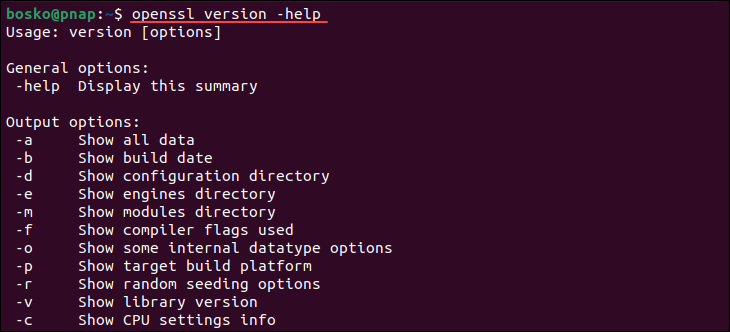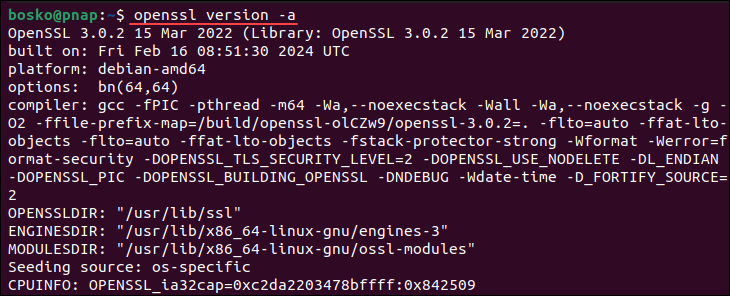Step-by-Step Guide to Checking OpenSSL Version
Step 1: Open Terminal or Command Prompt
First, open the terminal on your system. This applies to all operating systems, including Linux, macOS, and Windows.
Step 2: Execute the OpenSSL Version Command
To check the installed OpenSSL version, run the following command:
openssl versionThe command will return output similar to this:
OpenSSL 1.1.1k 25 Mar 2021Here, 1.1.1k is the version number, and 25 Mar 2021 is the release date.
The output shows the OpenSSL version designation and the date of its initial release:
We can break down the version format to get valuable insight. Additionally, using flags helps structure the data. The sections below explain how to understand the version information in detail and how to use flags to format the data.
Understanding the OpenSSL Version Format
The version information format provides a lot of information. The position of the numbers represents the release type:
- Major Releases. You can recognize a major release if the first digit changes. This type of release can break compatibility with previous versions, for example, 2.0.0 vs. 3.0.0.
- Minor Releases. A minor release changes the second number of the version designation, e.g., 3.0.0 vs. 3.1.0. These releases are likely to contain new features; however, they should not break binary compatibility. You do not need to recompile applications to benefit from them.
- Patch Releases. A patch release changes the final number in the version, fe.g., 3.0.0 vs. 3.0.1. It only contains bug and security fixes, and the API and ABI remain compatible across patch releases.
OpenSSL Version Command: Flags
There are several flags that modify the
openssl versioncommand output.The
-helpflag lets you see an overview of all valid options for theopenssl versioncommand:openssl version -help
The output shows the options that allow you to narrow down your search. The option that provides the most comprehensive set of information is:
openssl version -aThe
-aflag compiles all the information contained under the individual flags into a single output:
This option is convenient when troubleshooting or composing a bug report.
The
OPENSSLDIRline tells you where OpenSSL looks for its configurations and certificates. You can print that specific line by specifying the-dflag:openssl version -d
In the example above, the configuration files and certificates are located at /usr/lib/ssl.
If you specify the
-cflag, the command provides CPU information that indicates which cryptographic operations or optimizations OpenSSL can take advantage of based on your CPU’s capabilities. For example:
In the example above:
0xc2da2203478bffffrepresents a set of 64 bits, each corresponding to a specific CPU feature or capability.0x842509represents additional CPU features or optimizations specific to OpenSSL.
OpenSSL uses this information to detect certain CPU capabilities that can be used to optimize cryptographic operations.
Check OpenSSL Version on Different Operating Systems
Depending on your operating system, the method to check the OpenSSL version might slightly vary. Below are commands specific to popular OS environments:
1. Ubuntu/Debian
For Ubuntu or Debian-based systems, use:
sudo apt list --installed | grep opensslThis will list the installed OpenSSL version.
2. CentOS/RHEL
On CentOS or RHEL, check with:
rpm -q opensslThis command queries the installed OpenSSL package.
3. macOS
If you’re on macOS, especially with Homebrew, use:
brew info opensslThis will provide details about the OpenSSL installation.
4. Windows
For Windows users, first, find the OpenSSL installation path:
where opensslNavigate to the directory and run:
openssl versionWhy Checking Your OpenSSL Version is Important
Keeping your OpenSSL version up-to-date ensures compatibility with the latest security protocols and reduces vulnerabilities. Make sure to regularly check and update OpenSSL.



